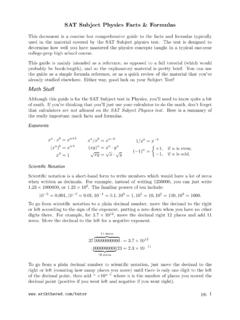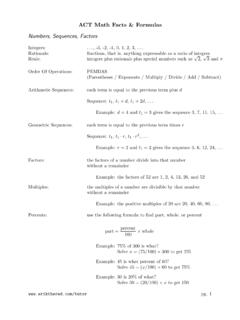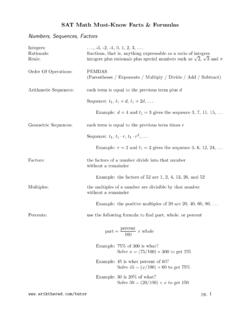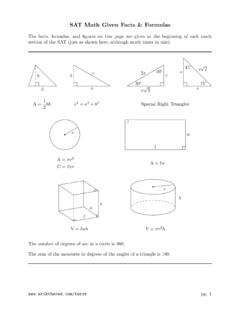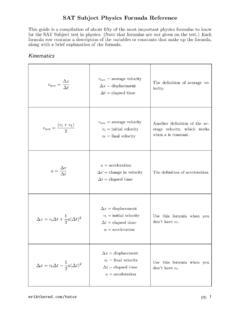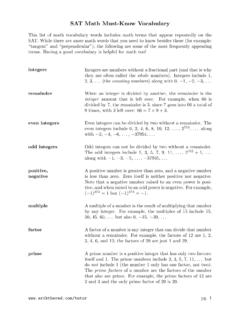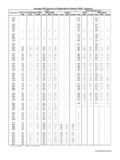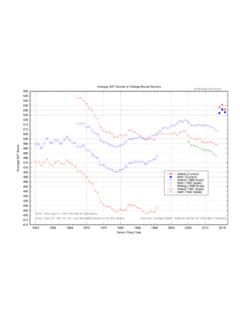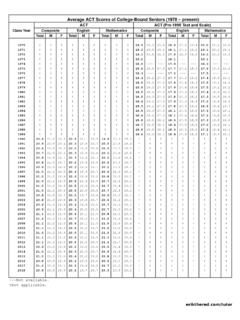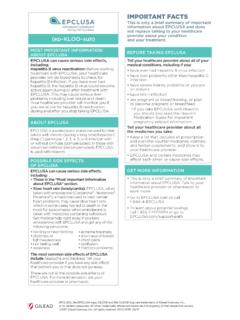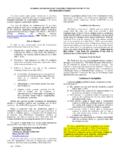Transcription of SAT Subject Math Level 2 Facts & Formulas Numbers ...
1 SAT Subject Math Level 2 Facts & Formulas Numbers , Sequences, Factors Integers: .. , -3, -2, -1, 0, 1, 2, 3, .. Reals: integers plus fractions, decimals, and irrationals ( 2, 3, , etc.). Order Of Operations: PEMDAS. (Parentheses / Exponents / Multiply / Divide / Add / Subtract). Arithmetic Sequences: each term is equal to the previous term plus d Sequence: t1 , t1 + d, t1 + 2d, .. The nth term is tn = t1 + (n 1)d number of integers from in to im = im in + 1. Sum of n terms Sn = (n/2) (t1 + tn ). Geometric Sequences: each term is equal to the previous term times r Sequence: t1 , t1 r, t1 r 2 , .. The nth term is tn = t1 r n 1. Sum of n terms Sn = t1 (r n 1)/(r 1). Sum of infinite sequence (r < 1) is S = t1 /(1 r). Prime Factorization: break up a number into prime factors (2, 3, 5, 7, 11, .. ). 200 = 4 50 = 2 2 2 5 5. 52 = 2 26 = 2 2 13. Greatest Common Factor: multiply common prime factors 200 = 2 2 2 5 5.
2 60 = 2 2 3 5. GCF(200, 60) = 2 2 5 = 20. Least Common Multiple: check multiples of the largest number LCM(200, 60): 200 (no), 400 (no), 600 (yes!). Percentages: use the following formula to find part, whole, or percent percent part = whole 100. pg. 1. SAT Subject Math Level 2 Facts & Formulas Averages, Counting, Statistics, Probability sum of terms average =. number of terms total distance average speed =. total time sum = average ( number of terms). mode = value in the list that appears most often median = middle value in the list (which must be sorted). Example: median of {3, 10, 9, 27, 50} = 10. Example: median of {3, 9, 10, 27} = (9 + 10)/2 = Fundamental Counting Principle: If an event can happen in N ways, and another, independent event can happen in M ways, then both events together can happen in N M ways. (Extend this for three or more: N1 N2 N3 .. ). Permutations and Combinations: The number of permutations of n things is n Pn = n!
3 The number of permutations of n things taken r at a time is n Pr = n!/(n r)! The number of permutations of n things, a of which are indistinguishable, b of which are indistinguishable, etc., is n Pn /(a! b! ..) = n!/(a! b! ..).. The number of combinations of n things taken r at a time is n Cr = n!/ (n r)! r! Probability: number of desired outcomes probability =. number of total outcomes The probability of two different events A and B both happening is P (A and B) = P (A) P (B), as long as the events are independent (not mutually exclusive). If the probability of event A happening is P (A), then the probability of event A not happening is P (not A) = 1 P (A). pg. 2. SAT Subject Math Level 2 Facts & Formulas Logic (Optional): The statement event A implies event B is logically the same as not event B implies not event A . However, event A implies event B is not logically the same as event B implies event A.
4 To see this, try an example, such as A = {it rains} and B = {the road is wet}. If it rains, then the road gets wet (A B); alternatively, if the road is not wet, it didn't rain (not B not A). However, if the road is wet, it didn't necessarily rain (B 6 A). Powers, Exponents, Roots xa xb = xa+b xa /xb = xa b 1/xb = x b (xa )b = xa b (xy)a = xa y a . n +1, if n is even;. ( 1) =. 0. x =1 xy = x y 1, if n is odd.. If 0 < x < 1, then 0 < x3 < x2 < x < x< 3. x < 1. Factoring, Solving (x + a)(x + b) = x2 + (b + a)x + ab FOIL . a2 b2 = (a + b)(a b) Difference Of Squares . a2 + 2ab + b2 = (a + b)(a + b). a2 2ab + b2 = (a b)(a b). x2 + (b + a)x + ab = (x + a)(x + b) Reverse FOIL . You can use Reverse FOIL to factor a polynomial by thinking about two Numbers a and b which add to the number in front of the x, and which multiply to give the constant. For example, to factor x2 + 5x + 6, the Numbers add to 5 and multiply to 6, , a = 2 and b = 3, so that x2 + 5x + 6 = (x + 2)(x + 3).
5 To solve a quadratic such as x2 +bx+c = 0, first factor the left side to get (x+a)(x+b) = 0, then set each part in parentheses equal to zero. , x2 + 4x + 3 = (x + 3)(x + 1) = 0 so that x = 3 or x = 1. The solution to the quadratic equation ax2 + bx + c = 0 can always be found (if it exists). using the quadratic formula : . b b2 4ac x= . 2a Note that if b2 4ac < 0, then there is no solution to the equation. If b2 4ac = 0, there is exactly one solution, namely, x = b/2a. If b2 4ac > 0, there are two solutions to the equation. pg. 3. SAT Subject Math Level 2 Facts & Formulas To solve two linear equations in x and y: use the first equation to substitute for a variable in the second. , suppose x + y = 3 and 4x y = 2. The first equation gives y = 3 x, so the second equation becomes 4x (3 x) = 2 5x 3 = 2 x = 1, y = 2. Solving two linear equations in x and y is geometrically the same as finding where two lines intersect.
6 In the example above, the lines intersect at the point (1, 2). Two parallel lines will have no solution, and two overlapping lines will have an infinite number of solutions. Functions A function is a rule to go from one number (x) to another number (y), usually written y = f (x). The set of possible values of x is called the domain of f (), and the corresponding set of possible values of y is called the range of f (). For any given value of x, there can only be one corresponding value y. Translations: The graph of y = f (x h) + k is the translation of the graph of y = f (x) by (h, k) units in the plane. Absolute value: . +x, if x 0;. |x| =. x, if x < 0. |x| < n n < x < n |x| > n x < n or x > n Parabolas: A parabola parallel to the y-axis is given by y = ax2 + bx + c. If a > 0, the parabola opens up. If a < 0, the parabola opens down. The y-intercept is c, and the x-coordinate of the vertex is x = b/2a.
7 Note that when x = b/2a, the y-value of the parabola is either a minimum (a > 0) or a maximum (a < 0). Ellipses: An ellipse is essentially a squashed circle. The equation of an ellipse centered on the origin which intersects the x-axis at ( a, 0) and the y-axis at (0, b) is: x2 y2. + = 1. a2 b2. pg. 4. SAT Subject Math Level 2 Facts & Formulas Hyperbolas (Optional): A hyperbola looks like two elongated parabolas pointed away from one another. The equation of a hyperbola centered on the origin, pointing down the positive and negative x-axes, and which intersects the x-axis at ( a, 0) is: x2 y2. = 1. a2 b2. Compound Functions: A function can be applied directly to the y-value of another function. This is usually written with one function inside the parentheses of another function. For example: f (g(x)) means: apply g to x first, then apply f to the result g(f (x)) means: apply f to x first, then apply g to the result f (x)g(x) means: apply f to x first, then apply g to x, then multiply the results For example, if f (x) = 3x 2 and g(x) = x2 , then f (g(3)) = f (32 ) = f (9) = 3 9 2 = 25.
8 Inverse Functions: Since a function f () is a rule to go from one number (x) to another number (y), an inverse function f 1 () can be defined as a rule to go from the number y back to the number x. In other words, if y = f (x), then x = f 1 (y). To get the inverse function, substitute y for f (x), solve for x in terms of y, and substitute f 1 (y) for x. For example, if f (x) = 2x + 6, then x = (y 6)/2 so that f 1 (y) = y/2 3. Note that the function f (), given x = 1, returns y = 8, and that f 1 (y), given y = 8, returns x = 1. Usually, even inverse functions are written in terms of x, so the final step is to substitute x for y. In the above example, this gives f 1 (x) = x/2 3. A quick recipe to find the inverse of f (x) is: substitute y for f (x), interchange y and x, solve for y, and replace y with f 1 (x). Two Facts about inverse functions: 1) their graphs are symmetric about the line y = x.
9 And 2) if one of the functions is a line with slope m, the other is a line with slope 1/m. Logarithms (Optional): Logarithms are basically the inverse functions of exponentials. The function logb x answers the question: b to what power gives x? Here, b is called the logarithmic base . So, if y = log the logarithm function gives the number y such that by = x. For example, b x, then . log3 27 = log3 33 = log3 33/2 = 3/2 = Similarly, logb bn = n. pg. 5. SAT Subject Math Level 2 Facts & Formulas The natural logarithm ln x is just the usual logarithm function, but with base equal to the special number e (approximately ). A useful rule to know is: logb xy = logb x + logb y. Complex Numbers A complex number is of the form a + bi where i2 = 1. When multiplying complex Numbers , treat i just like any other variable (letter), except remember to replace powers of i with 1 or 1 as follows (the pattern repeats after the first four): i0 = 1 i1 = i i2 = 1 i3 = i i4 = 1 i5 = i i6 = 1 i7 = i For example, using FOIL and i2 = 1: (1 + 3i)(5 2i) = 5 2i + 15i 6i2 = 11 + 13i.
10 Lines (Linear Functions). Consider the line that goes through points A(x1 , y1 ) and B(x2 , y2 ). p Distance from A to B: (x2 x1 )2 + (y2 y1 )2.. x1 + x2 y 1 + y 2. Mid-point of the segment AB: , 2 2. y2 y1 rise Slope of the line: =. x2 x1 run Point-slope form: given the slope m and a point (x1 , y1 ) on the line, the equation of the line is (y y1 ) = m(x x1 ). Slope-intercept form: given the slope m and the y-intercept b, then the equation of the line is y = mx + b. To find the equation of the line given two points A(x1 , y1 ) and B(x2 , y2 ), calculate the slope m = (y2 y1 )/(x2 x1 ) and use the point-slope form. Parallel lines have equal slopes. Perpendicular lines ( , those that make a 90 angle where they intersect) have negative reciprocal slopes: m1 m2 = 1. pg. 6. SAT Subject Math Level 2 Facts & Formulas a b . l a b a . b b . a a . b . m b a . Intersecting Lines Parallel Lines (l k m).
